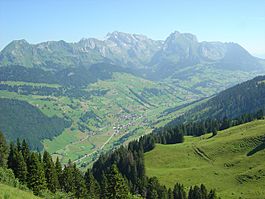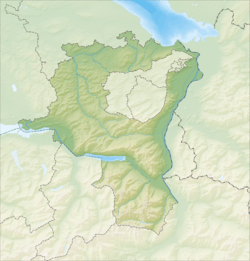Alt St. Johann facts for kids
Quick facts for kids
Alt St. Johann
|
||
|---|---|---|
 |
||
|
||
| Country | Switzerland | |
| Canton | St. Gallen | |
| District | Toggenburg | |
| Area | ||
| • Total | 53.10 km2 (20.50 sq mi) | |
| Elevation | 895 m (2,936 ft) | |
| Population
(Dec 2009)
|
||
| • Total | 1,466 | |
| • Density | 27.608/km2 (71.505/sq mi) | |
| Postal code |
9656
|
|
| Surrounded by | Amden, Grabs, Nesslau-Krummenau, Quarten, Stein, Walenstadt, Wildhaus | |
Alt St. Johann is a village located in the Toggenburg region of Switzerland. Since 2010, it has been part of the larger municipality called Wildhaus-Alt St.Johann. This change happened when the old villages of Alt St. Johann and Wildhaus joined together on January 1, 2010. The village is in the canton of St. Gallen.
Contents
History of Alt St. Johann
Alt St. Johann is a place with a long history. It was once home to a monastery, which is a building where monks live and work. This monastery was dedicated to Saint John the Baptist and was first mentioned way back in 1152.
Around the year 1200, a castle called Starkenstein was built here by a noble family known as the counts of Werdenberg-Montfort. Later, in 1414, the castle became the property of the counts of Toggenburg. After their family line ended, the castle went to the St. Johann abbey (monastery).
The village itself, then called Sant Johann, was first mentioned in records in 1439. In 1626, the St. Johann monastery had to move to a new location, which is now called Neu St. Johann (New Saint John's). Because of this move, the original village became known as Alt St. Johann (Old Saint John's) to show it was the first site of the monastery.
As mentioned, Alt St. Johann and Wildhaus officially joined to form the new municipality of Wildhaus-Alt St. Johann on January 1, 2010.
Geography of Alt St. Johann
Alt St. Johann covers an area of about 53.1 square kilometers (about 20.5 square miles). A big part of this land, about 54.7%, is used for farming. Forests cover another 31.4% of the area. Only a small part, 2.1%, has buildings or roads, while the rest (11.8%) is made up of things like rivers or lakes.
Before the merger in 2010, Alt St. Johann was a municipality in the Toggenburg constituency. It included the main villages of Alt St. Johann and Unterwasser, along with a smaller settlement called Starkenbach, which is on the valley floor. Higher up on the valley sides, you can find scattered homes and even seasonal alpine settlements. These are places where people live with their animals during the warmer months, especially on the northern slopes of the Churfirsten mountains and into the Alpstein mountain range.
People and Population
As of 2009, Alt St. Johann had a population of 1,466 people. A small part of the population, about 9.4%, were people from other countries.
Most people in Alt St. Johann speak German, which is spoken by about 93% of the population. Other languages spoken include Serbo-Croatian and Albanian.
The population includes people of all ages. In 2000, about 10.9% of the population were children aged 0 to 9 years old, and 17.3% were teenagers aged 10 to 19. The rest were adults and seniors.
Many people in Alt St. Johann live in families. In 2000, about 57.3% of people lived in a household with a couple and children. About 18.8% were couples without children, and 12.3% lived alone.
In the 2007 federal election, the most popular political party was the SVP.
People in Alt St. Johann are generally well-educated. Many adults have completed upper secondary education or even higher education at a university or specialized school.
Here's a look at how the population has changed over the years:
| year | population |
|---|---|
| 1827 | 1,618 |
| 1850 | 1,623 |
| 1900 | 1,504 |
| 1950 | 1,434 |
| 2000 | 1,453 |
Important Heritage Site
There's a special place in Alt St. Johann called Wildenmannlisloch, which is a paleolithic cave. This cave is very important and is listed as a Swiss heritage site of national significance. This means it's a valuable historical or cultural place for the whole country.
Economy and Jobs
In 2007, the unemployment rate in Alt St. Johann was very low, at just 0.78%. This means almost everyone who wanted a job had one.
The economy of Alt St. Johann involves different types of work:
- Primary sector: This includes jobs like farming and forestry. In 2005, about 164 people worked in this sector, with 66 businesses.
- Secondary sector: This involves manufacturing and construction. About 151 people worked in this sector, with 26 businesses.
- Tertiary sector: This includes jobs in services, like shops, hotels, and tourism. About 448 people worked in this sector, with 80 businesses.
Many people who live in Alt St. Johann also work there. In 2000, 505 residents worked within the municipality. Some people traveled to other places for work, and some people traveled into Alt St. Johann to work.
Religion
Based on information from the 2000 census, many people in Alt St. Johann belong to Christian faiths. About 46.9% were Roman Catholic, and 36.5% belonged to the Swiss Reformed Church. There were also people who belonged to other Christian churches, as well as those who followed Islam. Some people did not belong to any church or preferred not to say.
Images for kids
See also
 In Spanish: Alt Sankt Johann para niños
In Spanish: Alt Sankt Johann para niños






